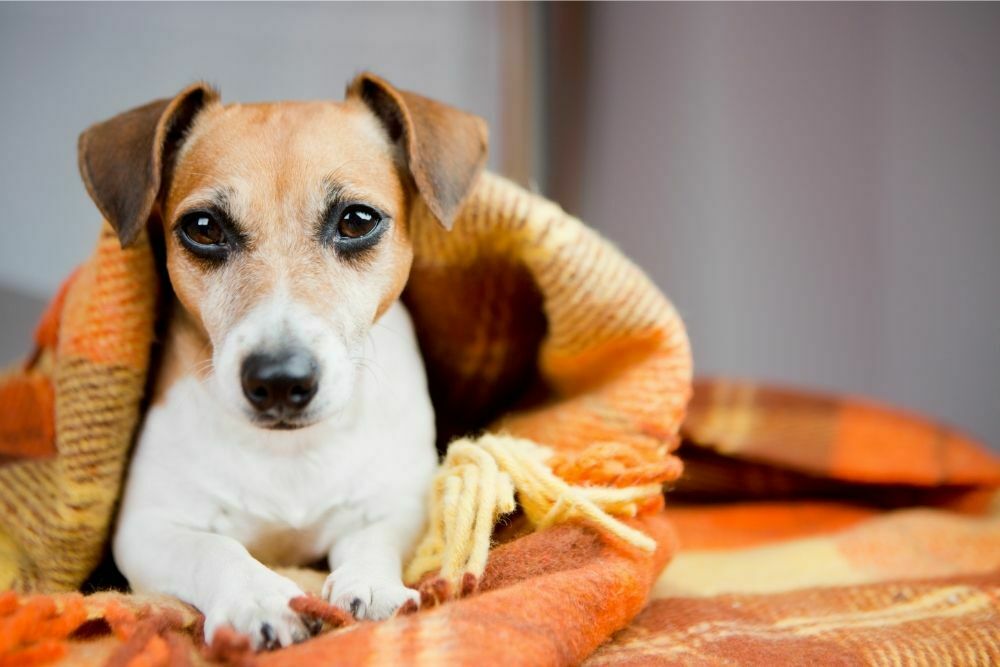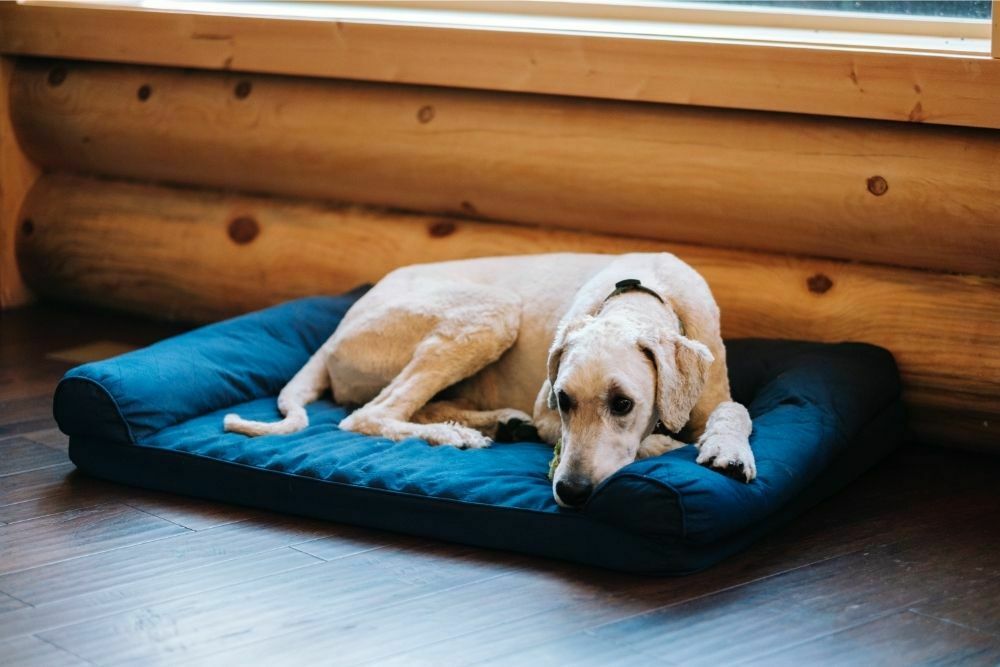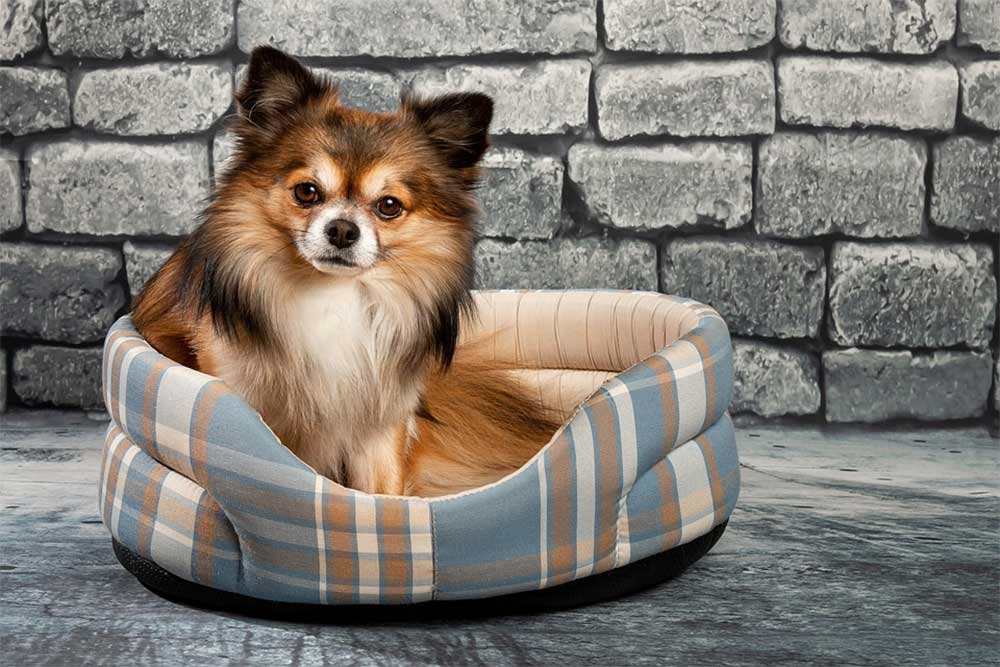As the seasons change and the weather adjusts, we humans break out our winter scarves, hats, and gloves in order to keep the frost at bay.

Though the majority of dogs have a nice thick coat to keep them toasty, just like us, they require some extra padding for when the temperature drops.
It is especially important in particular to make these adjustments for pups who sleep outside, in the garage, or colder areas of the house, or who have shorter fur.
Whether your canine companion sleeps soundly inside on a soft bed or is happier in a kennel in the yard, you must keep them warm enough.
The following tips will help you make sure they always fall asleep in total comfort and will never be too chilly, so you can get your full eight hours knowing they’re okay.
Failing to provide enough warmth could result in your dog becoming unwell or even experiencing the fatal consequences of hypothermia.
Don’t even entertain that possibility: make sure you’re prepared right now.
Ways To Keep Your Dog Warm At Night When They’re Inside
Of course, if you have central heating in your home, you shouldn’t worry too much because the pipes and radiators will send waves of warmth around the house.
But if you’re worried or believe your dog is showing signs of being cold, here are some ideas to put in place, so they sleep soundly and without interrupting yours!
1. Ensure They Have A Cozy Place To Sleep
Would you like to sleep on a cold, hard floor? No? Didn’t think so! Even though some pups are happy enough to curl up on the ground when it’s bedtime, they’ll be way comfier, happier, and, most importantly, warmer with a nice padded bed just for them.
The best kinds are those with wide, high sides that trap heat once your dog is curled up inside them, keeping your pup perfectly temperate all night long. That being said, if your dog is a chewer who can’t be trusted with soft beds – don’t despair!
It’s possible to get a heated mat like this one for them to sleep on. They are similar to the electric blankets that we humans would use, only a lot safer for your furry friend, and without exposing cables, they might chew on.
2. Make Them A Bedtime Blanket Nest
Sometimes just a bed itself, however plush, isn’t enough. Just like us humans, your dog might need some additional blankets in order to achieve a comfortable sleeping temperature. It doesn’t need to be anything fancy – the generic fleece kind is fine.
Get a couple for your pup (or scavenge linen around the house that you don’t mind your furry friend snoozing on top of) and create a donut-shaped nest in their bed, which they can then walk around in circles on top of and collapse in that funny way.
Remember to regularly wash these blankets (and the bed itself if that is machine washable) as you don’t want any buildup of bacteria – unless you’re trying to make your house smell like a wet dog.
Have spares on hand in case they aren’t dry in time for bed!
3. Eliminate All Potential Drafts In The House
Even though you might not be able to feel a draft in a room, it’s possible there’s one affecting your dog, who is at a considerably lower height than you. Search the room (or rooms) they tend to sleep in and try to find any potential sources of cold.
Bear in mind that they tend to sleep a lot closer to the floor than we do, so your primary targets are drafts coming from your vents or underneath doors. These can be easily rectified by closing the vents and covering door bottoms with draft blockers.
You don’t even need to buy a proper draft exclusion kit – towels or blankets work fine! If, after eliminating all of the possible draft causes, your dog still seems to be struggling to sleep, it could be worth following the next tip, which is…
4. Opt For A Raised Bed
If you have wooden floors in your home, you’ll know too well just how cold they can be in the morning, as the heat rises during the night and leaves the downstairs unpleasantly chilly when you rise again.
This issue also affects your dog’s bed, which can decrease in temperature quite a lot overnight while pressed against a cold floor. In order to get around this, you can get them a raised bed that isn’t that much taller but still sits slightly above the ground.
They aren’t the coziest looking places for your pups to rest their head, although they’re perfectly comfortable, as the reviews attest, so you might want to add those blankets we talked about earlier on top and some cushions if they won’t get chewed!
Raised beds have the double advantage of being cooler during the summer, preventing your dog from overheating when it’s really warm at night. If you’re struggling to sleep because it’s hot, then your dog probably is too.
5. Pick Out Some Pup Pajamas
Not every owner feels comfortable playing dress up with their dog, but sometimes you have to get over your snobbery in order to do what’s best for them. Of course, if your dog hates wearing anything, including a collar, you’ll probably struggle here.
That being said, other pups will adore the coziness that their special pajamas provide and look squee-inducingly cute while rocking them. Make sure you get the right size and nothing too thick, or they could end up overheating!
Much as we humans can get special thermal pajamas for winter and thinner sets for summer, the same applies to PJs for your dog. A pair for every season sounds justifiable if it’s in their best interest, right?
6. Find A Dog Friendly Heated Blanket/Bed
Heated pads were already mentioned above, but did you know it’s possible to get a dog bed that’s fully formed AND also warms up when you want it to? Well, now you do. This one from K&H Pet Products is an especially popular option.
Most of them feature a heater that can be removed and re-added whenever you’d like, meaning the bed is suitable all year round. Simply take out the heater in summer and pop it back in again when things get a little chilly!
Make sure you choose a highly-rated product made by a reputable manufacturer, as you’ll leave this turned on overnight and allow your dog to sleep in it unsupervised. Therefore, you need total assurance that nothing will malfunction.

Ways To Keep Your Dog Warm At Night When They’re Outside
Unless your dog prefers to sleep outside these days, it’s probably best to let them snooze in the comfort of your home.
Not to be harsh, but if you can’t accept that they may need to be welcomed into your home overnight, then you shouldn’t have a pet.
As domesticated animals, they may feel rejected if the rest of their pack (aka you and the rest of your family) are sleeping away from them.
Plus, depending on where you live, the autumn and winter months can be brutally cold out, making it unsafe for animals to sleep outside.
That being said, not everybody has the luxury of the room, and some breeds are more equipped to catch their z’s in the yard, particularly working dogs.
In winter especially, temperatures can drop sharply overnight, so even the chunkiest hairiest dogs should be brought indoors.
When it is safe and sensible to allow your canine companion to enjoy their dreams outdoors, the following tips will help ensure they’re cozy.
1. Pick The Warmest Possible Kennel
Allowing your dog to sleep outside entirely exposed to the elements is just bad ownership and neglect. Even the dogs with the thickest coats don’t want to snooze in the wind and rain!
It is your obligation to pick out the warmest, safest, sturdiest kennel in your prize point, ensuring it has more than enough room for your dog to stretch out and move around without straining too much or hurting themselves.
You should also definitely put a mat on the ground at the very least (choosing a suitable outdoor one), so they aren’t lying down on the ground directly – they’ll definitely appreciate some additional cushioning.
2. Stock The Sleeping Area With Thermal Blankets
As well as placing a mat or a bed in your dog’s kennel – a closed-in bed with high sides is always your best option over an open one – you should also make sure it is stocked with plenty of blankets or other bedding for curling up and nesting in.
For outside, you should opt for thermal blankets specifically if you can, as these are much better at retaining heat than their regular counterparts – though your dog isn’t fussy and will probably fall asleep on top of anything if it’s soft enough.
3. Try A Jacket Or Pyjamas
As mentioned above, dog clothing like a jacket or a pair of pajamas can be great for ensuring your pup gets plenty of warmth when bedtime comes around. When sleeping outside, however, you need to be more careful about which ones.
Especially if your pooch isn’t the biggest fan of wearing things, it’s important to make sure that the pajamas/jacket or choice won’t obstruct them when trying to curl up into a cozy ball and doesn’t have any zippers or tags that could be tempting to chew.
When your dog is away from you, they’ll feel less inclined to be on their best behavior, so it’s important to remove anything eye-catching to avoid possible choking hazards – after all, you’ll be in bed sleeping!
4. Make Sure Your Dog Is Dry Before Bed
Depending on what you’ve been up to that day, it’s necessary to check that your dog is bone dry before they head outside to bed – check particularly in between their paw pads and underneath their tummies and give a thorough toweling if damp.
It’s possible to get a canine-friendly kennel heat lamp, which can be left on overnight (or set up to run on timed intervals), ensuring that dogs are kept at a comfortable temperature even when it’s freezing outside.
5. Ensure You Have Fed And Watered Sufficiently
This is an obvious one, as giving food and water to a pup is second nature.
However…
Did you know that if your dog is hungry or thirsty, they will also be colder? It’s possible to get a heated bowl so you can provide them with water that won’t freeze overnight if that’s a problem. Plus, they won’t be irritated and kept awake by thirst!
Always feed your pup at a sensible time, too, so that their body is full of enough grub that it can burn off calories in the event their body temperature drops, which is a good safeguarding measure.

Frequently Asked Questions
How can I tell if my dog is too cold?
There are several physical signs or symptoms your dog can display, which can – amongst other things – be indicative that your dog is feeling too cold. These are:
- Trying to come back inside (if outside)
- Whining or barking continuously
- Shivering or shaking
- Continuously lifting their paws up off the ground
- Weird behavior they don’t normally engage in
- Seeming anxious or uncomfortable with constant wriggling, like they can’t settle properly
- Trying to find somewhere to curl up and hide where they feel sheltered
- A hunched over, stooped posture, with their tail tucked in between their legs
Far more serious are the symptoms that indicate your dog is suffering from hypothermia. If your dog displays any of these behaviors, get something warm around them, keep them as cozy as possible and call the vet ASAP:
- Dilated pupils that won’t move or react to stimulus
- Seeming sluggish and unresponsive, lethargic movement
- Weakness that isn’t normally there or stiffness of muscles
- Behaving as if they are “in a trance” – staggering
- Sudden loss of consciousness for no other reason
Of course, in an ideal world, you want to avoid even getting to this point! A good rule of thumb is if it’s too cold for you, then it’s too cold for your dog! Make sure you’ve provided some if not all of the suggestions we have made above.
Is it too cold for dogs to sleep outside?
That depends on several factors, including the breed of dog you have, their age, and the conditions that they sleep in. According to most professionals, anything 45 degrees Fahrenheit and above should be safe enough for your dog.
This temperature should be increased when you have an older dog, a smaller breed, or your pup has an existing illness, as their ability to withstand the cold is reduced in these circumstances and must be accommodated.
It probably is if you’re unsure whether it’s too cold for your dog outside. Err on the side of caution and keep them inside – or if that’s not an option, make sure they have more than enough cushions and blankets, and consider getting a dog-friendly heater too.
Should I cover my dog with a blanket at night?
You can if you want to! Dogs love being cozy, just like humans, so they’ll definitely appreciate the warmth and soothing comfort that a nice blanket provides. That said, you don’t want to restrict their movement or use anything too heavy.
As long as you’re sure they’d be able to wiggle free of the blanket and lie back on top of it if they get too hot, you’re more than fine to cover them up. Proceed with caution if your pup is injured or elderly, as they could hurt themselves trying to escape!
Again, make sure that you’ve not covered up their nose or mouth or obstructed their breathing in any way, and they should be absolutely fine. Much as you’d lay a blanket over a human baby if you thought they were cold, it’s safe and often recommended to do the same for your fur baby!
